The trip today went to see LZB, LZA, and MZ layering, and a wide variety of roof rocks, fallen to the floor as autolith blocks.

Loading up the Zodiacs for the east side of Kramer Island.
These images are entirely within a ~250 m long autolith block

This block is located just to the left of the “D” in “UTTENTAL SUND” on the McBirney (1989) map. Strangely, the map only shows a small part of the actual autholith. The autolith assemblage is equivalent to UBZβ, which has no cumulus olivine. This photo shows the southern end of the giant gabbro block, with layered MZ rocks lapping up against the gabbro block edge. The giant block includes a smaller, light colored gabbroic troctolite block, visible to the right of the man (better photo below).

Layered gabbroic troctolite autolith (same as in the photo above), within the giant autolith block. This gabbroic troctolite block has An74 plagioclase, which is among the most primitive in the Skaergaard. This autolith is presumably from UBZT. The margin of the giant block is immediately to the left of the light-colored block, where the rocks are darker brown.
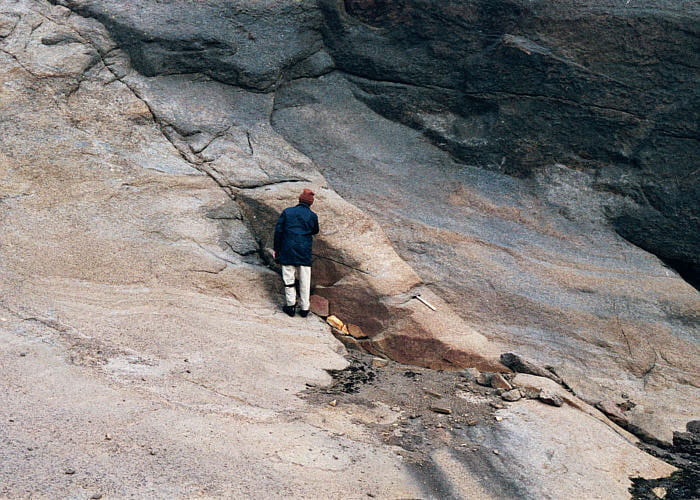
This shows some of the giant block interior, with diffuse layering seen below the man’s feet.
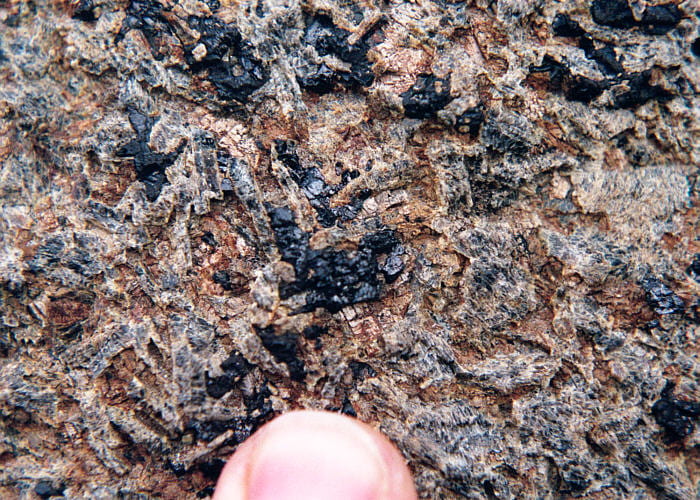
A coarse-grained portion of the giant gabbroic block, just to the left of the man’s knees in the photo above. This coarse rock rests on finer-grained layered rock, also visible in the photo above at and below the man’s feet. Mineralogy includes magnetite, plagioclase, and pyroxene (no olivine).
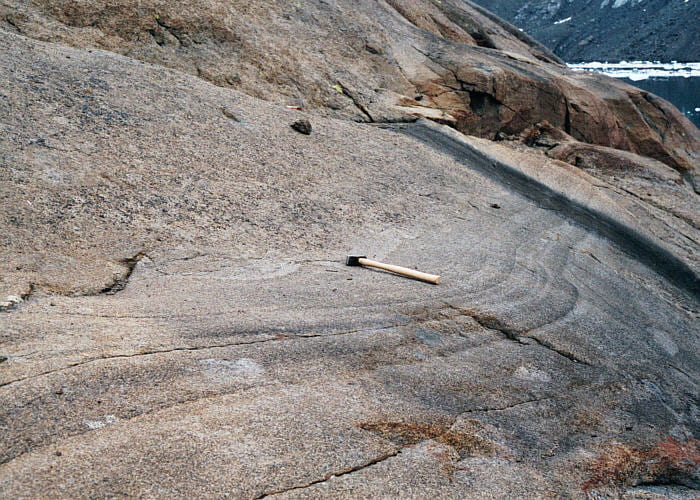
Looking northeast along the giant gabbro autolith block, showing the finer-grained modally graded layered rock and the coarser grained rock above it. Note that the grading is from dark bases upwards to light tops, the same as in the Layered Series. This suggests that layers in the UBZ have the same orientation as in the layered Series, and are not mirror images. Uttental Sund is visible in the top right.

Close-up of the finer-grained gabbroic rock in the photo above. Mineralogy includes magnetite, plagioclase, and pyroxene (again, no olivine).
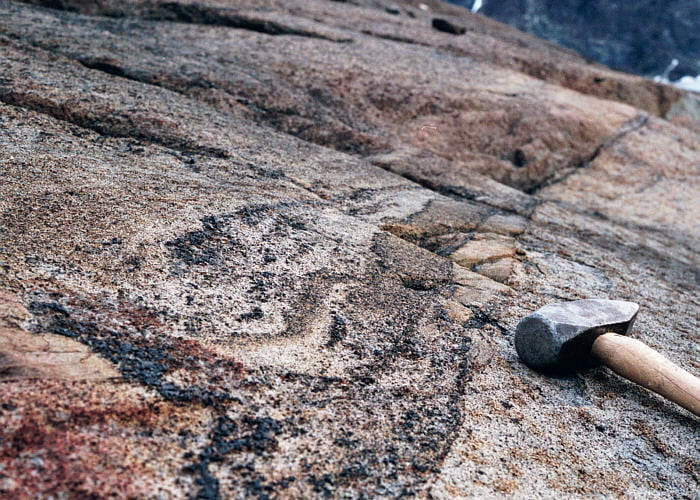
A complex, oxide-rich reaction rind on the upper contact of the giant autolith block (lower right) against the MZ Layered Series (left).

Another view of the contact at the top of the giant gabbro autolith block (lower left) with the MZ Layered Series (middle and right). In addition to a very thin oxide-rich contact zone, there is a broader fine-grained contact region that might be a chill zone against the block.

People standing on the giant gabbro autolith block. Rock here has very coarse oikocrysts of augite, giving the rock a mottled look. Because there is no lichen or algae on these rocks, the traction is excellent.

Splays at the end of a basalt dike that cuts the giant gabbro autolith block. The offset, en echelon continuation of the dike is to the upper left, which ends a few meters off the picture to the lower-left.

Faint modally graded layering within the giant gabbro autolith block. Note that the layers are normally graded, with mafic bottoms and felsic tops. The layering on the roof grades the same way as layering on the floor. The layers are here cut by a thin basaltic dike.

Small autolith block in the giant block. Here, up is to the left, so the draping of layers over the included felsic autolith is from the bottom, as expected.

Numerous small gabbroic troctolite autoliths in the giant gabbro block.
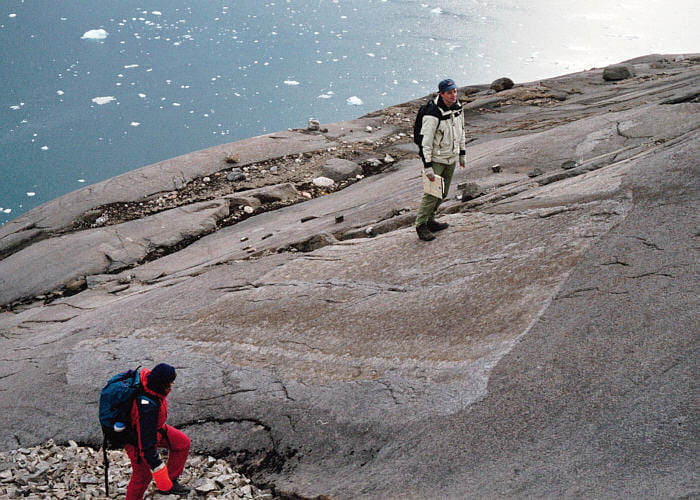
Angular autolith within the giant gabbroic autolith block. Tops are to the upper-right. The lower side of the autolith, next to the woman in red , looks like replacement gabbroic anorthosite, but the layers within the block are clear enough. The layering in the host giant block is difficult to see here, but it is at ~20° to the layering in the included block. This block has a very primitive composition and is presumably from UBZT.
Outside the giant autolith: Layered series and many autoliths

Layering around a small autolith block in the Layered Series MZ, below the giant gabbro block in the photos above. Lovely onlapping of the layers up the sides of this block, and draping of layers over it with pronounced thinning of layers over the top. Sharp, straight surface under the block shows the underlying rock was firm at the time of impact.
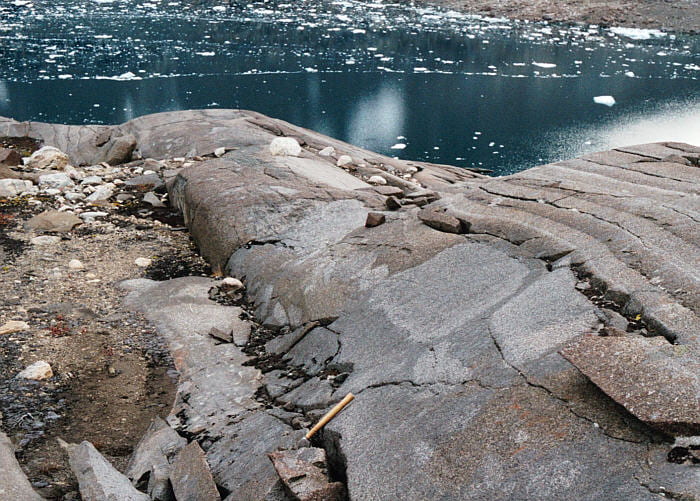
Autoliths strewn within a layer in the lower MZ. This suggests that blocks were distributed laterally by a current.

View of the upper part of LZc, right below the MZ, which is visible on the near horizon. Water in the distance is Uttental Sund, above which is the toe of Forbindelses Glacier. Numerous small autoliths are visible, as well as some layer truncations.

Just for the scenery, looking southeast from Kraemer Island, across LZc and Uttental Sund to Forbindelses Glacier. Lots of light-colored little autoliths in the layered rock.

Base of a medium size autolith block in LZc, showing irregular and disrupted graded layers below the block. These were clearly disturbed by block impact. We had lunch on this spot.

Unusual layering in LZb, on a little side trip I took for samples during lunch. This looks rather like a series of depositional and erosional features associated with channels and scouring currents, perhaps a more subtle version of the troughs found in UZa. Or, maybe it is different amounts of weathering, depending on how long the rock has been exposed at the surface.

Basaltic dike in LZb, with numerous xenoliths of felsic gneiss. These are presumably from below the Skaergaard. View is approximately to the east. Uttental Sund is barely visible at the top-left.
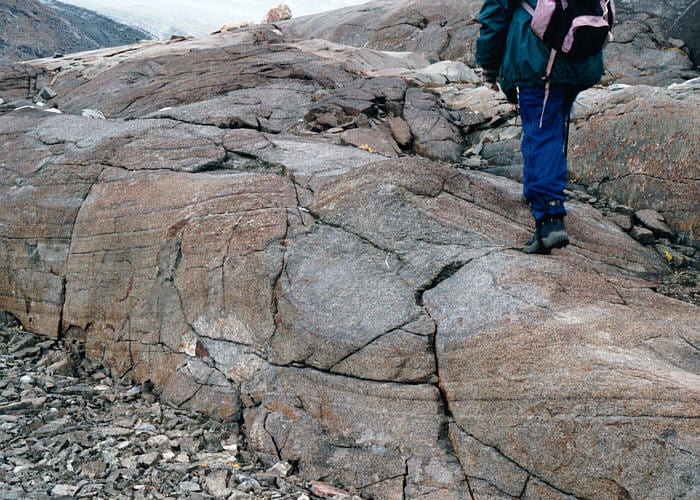
Three small autolith blocks in LZc, showing some deformation below the blocks, and thinned layers over them.
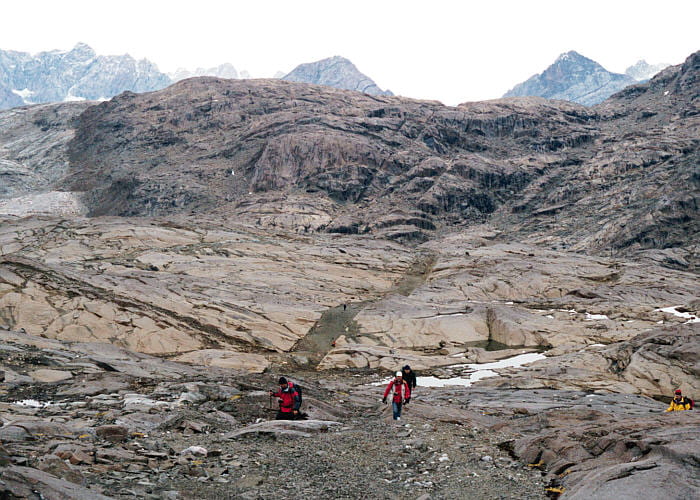
One of the so-called “tramway dikes,” wide basaltic dikes of great length that traverse the Skaergaard and surrounding gneisses, particularly on the pluton western side. This one has been broken up into gravel that makes a surprisingly smooth roadbed. View is to the north, with the rise in the background being Uttental Plateau on the other side of Uttental Sund. The western contact of the Skaergaard visible in the upper left, with dark-brown Skaergaard rocks in contact with the light-gray Archean gneiss. The mountains in the distance are on the other side of Watkins Fjord.
In and around one medium-size autolith block

This medium-size block block is between the yellow-jacketed man on the right and the orange-jacketed man on the left. The orange man is sitting on the lower contact of the block, and the yellow man is standing on the upper contact, looking at the mass of smaller blocks shown in photos below. View is to the east across Uttental Sound toward Forbindelses Glacier. Nunataks 1 and 2 are in the top-center, Basistoppen is to the top right.
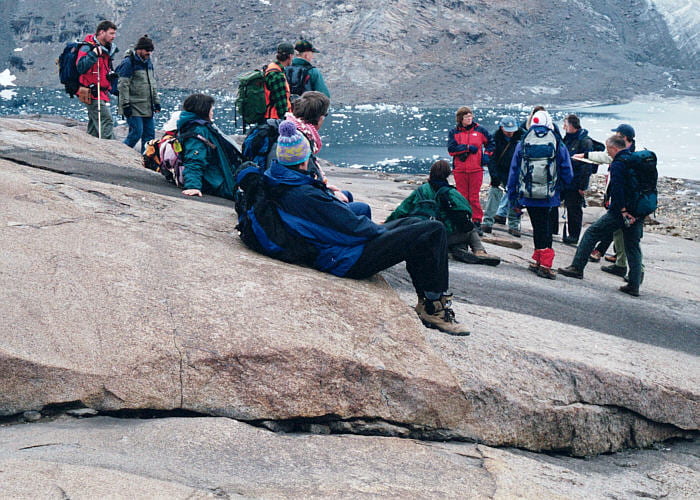
Lower contact (under nearest feet) of the gabbroic autolith (right) hosted in MZ larered series gabbro (brownish, left). The autolith is probably from UBZβ. Diffuse and distorted layering in underlying rocks to the left is the result of block impact, as is the fold in the photo below. View is to the east with Uttental Sund in the background.
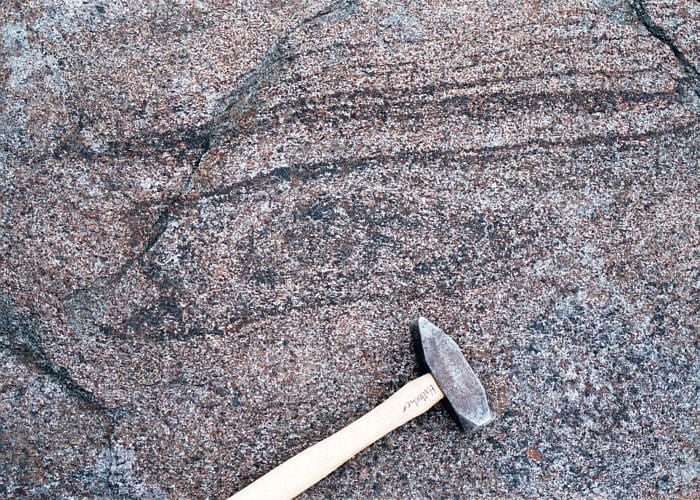
Photo of a sheath fold (or jelly roll?) in layers immediately beneath and to one side of the medium-size block shown above. This block is in a complex region with many other blocks, probably representing the collapse of a substantial part of the roof.
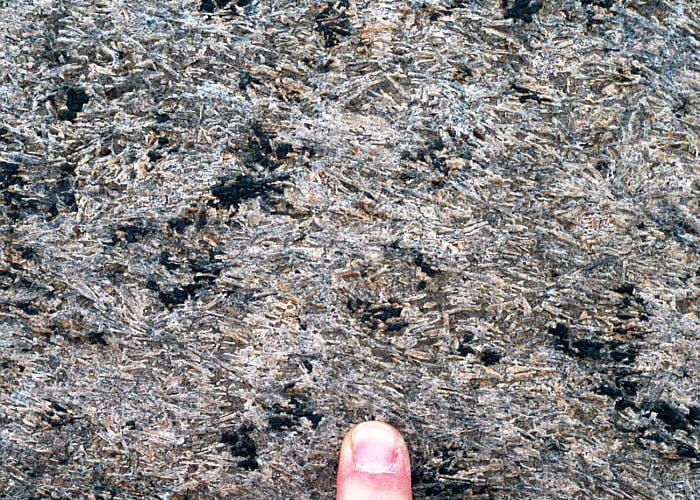
Close-up of the gabbroic block, showing that it is very coarse-grained and very plagioclase-rich, with a strong plagioclase foliation. The mineralogy is plagioclase and pyroxene with oikocrystic magnetite and interstitial olivine.

The medium-size block in the photos above is to the top left in this photo, behind the yellow jacket man. This photo shows numerous smaller gray blocks that lie on top of the larger one. Many of these blocks have olivine- and oxide-rich reaction rinds around them, with layering lapping up the sides of the blocks.
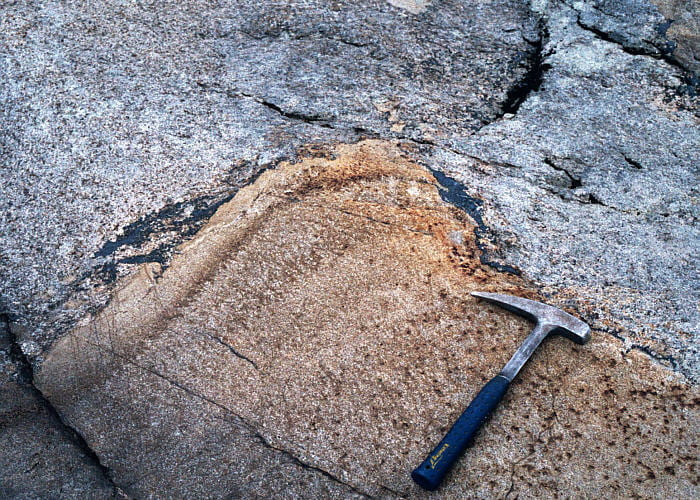
Close-up view of an irregular block (gray) with a magnetite-rich reaction rind, and brown MZ layers lapping up on the block sides.

Several blocks in the MZ, with a clear truncation of a rusty-weathering layer in the nearest block, and truncation of fainter layers in other blocks.

View across a gully eroded in a basaltic dike. At the center is the sharp upper point of a medium-sized autolith block. It shows thinned layers draped over the sharp upper point of the autolith. Another big block is visible above.
Further along to the south, away from the medium-size autolith block
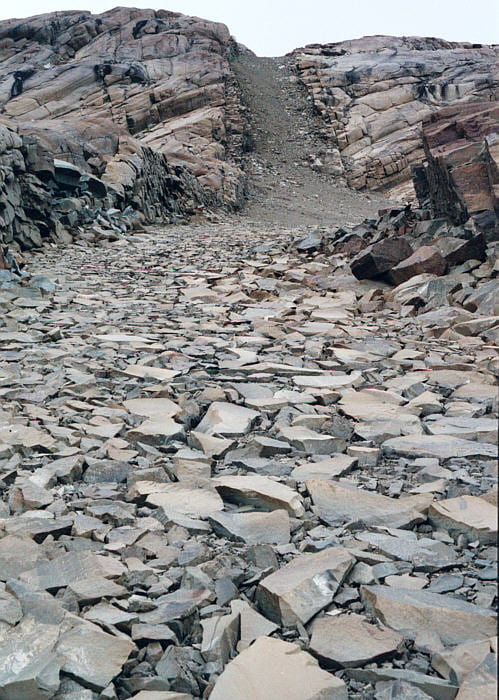
Another “tramway-style” basaltic dike with a remarkably smooth, flat, road-like surface, made of frost-oriented basaltic rocks. View is to the west.

Graded layers with abundant autoliths strewn within several of them. Again, this implies that they were distributed by currents, in this case doubtless the same currents that deposited the graded layers.

An autolith block with slightly deformed layers below it (lower left), with a body of mafic pegmatite located at the block bottom. Pegmatite on block bottoms is fairly common, implying that the blocks were relatively impermeable and that the pegmatizing ichors were migrating upward.

Looking south across a small pond, with cottony tufts on some plants. View in the distance is across the homestead area and Skaergaard Bay to the ship, located just beyond Skaergaard Bay.
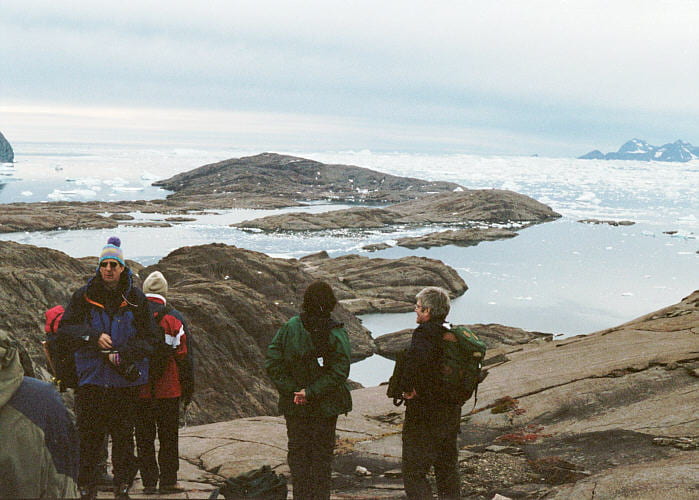
View south across Lille Mellemø, Ivnarmiut, and Skaergaard Peninsula, with the entrance to Uttental Sund in between. Tidal currents in these channels can reach 6 knots. The ship is on the far left.

Impressively dense assortment of angular autolith blocks, enclosed in darker MZ gabbro, seen on the way down to the shore.
Return to the ship

View to the northwest from the Zodiacs, returning to the ship. Archean gneiss in the distance. There is an enormous amount of ice in the Skærgården area today, moving in the tidal currents. This ride back to the boat required a lot of ice-dodging.

A 100 m iceberg rolling over, ~400 m from the zodiacs. The spray from the overturning berg is visible between the people. Basistoppen and Basis Glacier are visible in the background.

Approaching the ship in the Zodiacs. The conical spire is unnamed, 700 m.

With thickening overcast and forecast of a storm, the ship moves out of Skaergaard Bay into the open sea for the night. In the morning the destination will be to Mikis Fjord to keep out of the storm winds and to avoid moving ice.
